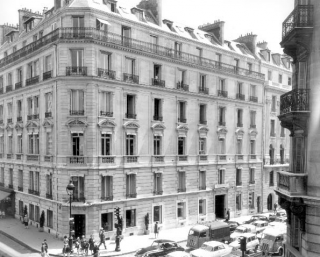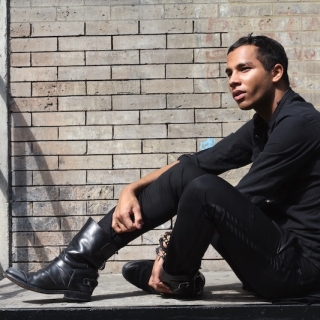ההיסטוריה של בית בלמן
In the period following World War II, Pierre Balmain was "a king of French fashion" and outfitted stars including Ava Gardner and Brigitte Bardot, the Nicaraguan first lady Hope Portocarrero,[3] and Queen Sirikit of Thailand. The brand is mentioned in the 1969 song "Where Do You Go To (My Lovely)?" by Peter Sarstedt, where he says in the lyrics, "Your clothes are all made by Balmain". During World War 2, resources worldwide were heavily rationed and an overall sacrifice was made in order to supply the war overseas. Fashion took the form of simple silhouettes that would use up the least amount of fabric, like shortened hemlines. Women were encouraged to forgo stockings, and some even used charcoal to draw lines on their legs to mimic the style of their stockings. After the war, fabric was no longer rationed and designers were encouraged to bring glamour and excess back to their creations. During this era, Christian Dior coined a silhouette that he named “The New Look.”[4] This style praised full skirts, nipped-in waistlines, and full shoulders. The bodices were heavily corseted and structured to create the illusion of an impossibly proportioned woman. The dresses were extravagant and lavish, a polar opposite of the modest and utilitarian styles worn during the war. Balmain was among the designers to adopt this look into their own aesthetic, in fact he has been said to have credited himself with the idea. His styles were effortless and refined while still remaining luxurious and opulent. He traveled the world lecturing on the fashion in France, during which time his attention was sparked by the US market and all its potential.
Being an extremely impractical art form, couture took a huge hit during the war. Ateliers utilized unconventional materials in their pieces and were forced to keep practicality in mind as their collections progressed with the modern woman. Couture is fashion made by hand explicitly for one individual wearer’s exact specifications; it takes thousands of man hours just to make one dress. Couture originated in Paris, which is renowned worldwide as the birthplace of high-end fashion.[5] Wealthy women would travel by steamship to preview a collection and then purchase pieces, giving preference to color and fabric. Couture items are one of a kind and the highest quality fashion available. Today, couture is a luxury almost only available to celebrities. Balmain had always set extremely high standards for couture. He believed in fashion that exuded elegance and simplicity and would stand the test of time and created pieces that would universally celebrate the human form. His aesthetic was always to create easy and glamorous looks that radiated style without being flashy or ostentatious.[6] Ever the epitome of French fashion, he detested overly decorated designs and preferred to stick to refined lines and extreme attention to detail. He singlehandedly created what his close personal friend, author Gertrude Stein, called the “New French Style” – an immaculately poised and well-dressed woman who was embodied in his 1949 fragrance Jolie Madame. His designs were worn on women with prestige, from royalty to theatre and ballet. He was well regarded in the world of couture until his death in 1982, after which designer Erik Mortensen took the reins of the house.
After Balmain's death in 1982, the house was led by Erik Mortensen, described by Vogue as "Pierre Balmain's right hand".[3] Mortensen had joined the house to work as Balmain’s assistant in 1951. After succeeding Balmain, Mortensen worked to maintain the brand aesthetic in the ever-living world of couture while still maintaining the progressive spirit of creativity in the fashion industry. He won two Golden Thimble awards, one for his Autumn/Winter collection of 83/84 and one for the Autumn/Winter collection of 87/88. He left the house in 1990. After his departure, designer Hervé Pierre took over until 1992 working as director of ready-to-wear and haute couture.
Possibly the most influential designer to take over at Balmain was Oscar de la Renta, who led the house between 1993 and 2002.[3] Already a fashion veteran before joining Balmain, De la Renta brought a famous face to the brand. He lived in New York City most of his life, although he was born in the Dominican Republic and became a naturalized United States citizen in 1971. He fit into the Balmain design aesthetic, with an eye for detail and classic silhouettes. He, like Balmain, preferred modest and simple design rather than extremely ornamental and flashy styles. Couture had been suffering at the time since it was an extremely impractical business, so Oscar joined the brand in order to challenge himself and to help it through the beginning of the decline of couture.[7]
After Oscar de la Renta’s departure Christophe Decarnin joined the house in 2005. Contrary to all the designers before him, Decarnin insisted on bringing the brand into the 21st century. He favored insanely expensive prices and flashy pieces that sharply contrasted with the label’s reputation for its classic and luxurious designs. He was considered a "star designer", and the brand became more about his star status than about its clothes.[8] In April 2011 Balmain announced that Decarnin was to be replaced by Olivier Rousteing.[9]
Rousteing had joined the company in 2009, after attending a prestigious French fashion school and working under Roberto Cavalli.[10] While he liked Decarnin’s aesthetic, he wanted to orient the label towards the finer aspects of French couture. At the time of his appointment, Rousteing was a relatively unknown designer, and has brought a much-needed fresh take on the brand’s aesthetic that remains to this day. He was credited with adding an Asian influence to the clothing, as Asia comprises a huge part of the
באדיבות: ויקיפדיה






